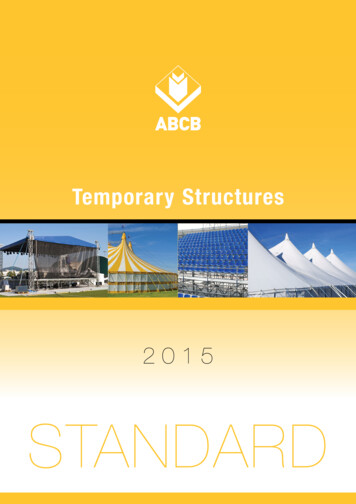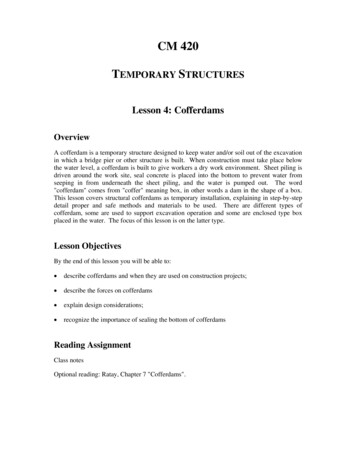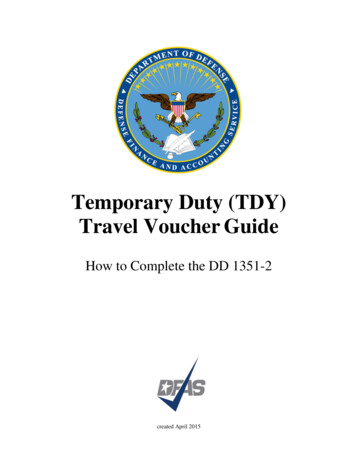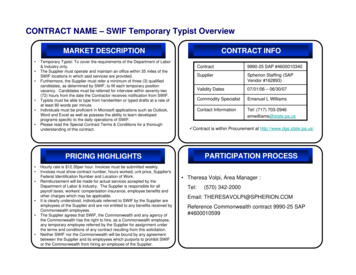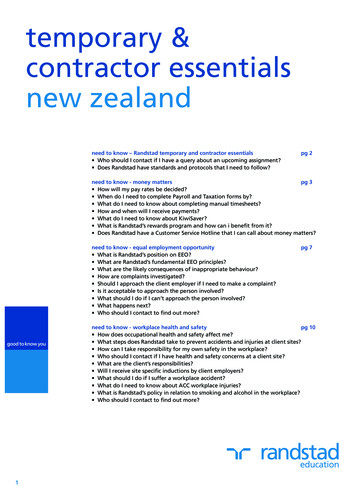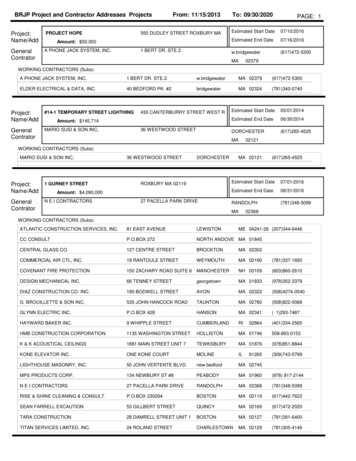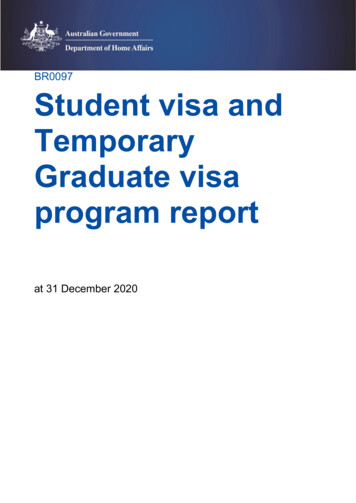
Transcription
BR0097Student visa andTemporaryGraduate visaprogram reportat 31 December 2020
This page is left blank intentionally.
Table of ContentsPageAbout this report1Enquiries1Definition of terms2Background to the student visa and temporary graduate visa program3Background to the subclass 485 visa6Executive summary7Section 1 Lodged9Section 2 Granted23Section 3 Grant rates45Section 4 Processing times49Section 5 On hand57Section 6 Visa holders in Australia61Section 7 Destinations67Section 8 Subclass 485 visa73
This page is left blank intentionally.
About this reportThis report provides bi-annual data about the student visa and temporary graduate visa program administered by theDepartment of Home Affairs (the department). The report has been produced to assist education providers,representative bodies and policymakers.Data is sourced from several departmental visa processing and recording systems. Data can be dynamic and there canbe delays in transmission of information from the department's global operations. Variations in figures between thisreport and previous issues can occur. The current financial year should always be considered provisional.For privacy reasons 5 has been used where a number in a table is between 1 and 4. Further data about the studentvisa program, including yearly student visa trends and comprehensive data on student visa grants by sector and countryfrom 2002-03 to the 2018-19 program year is available on the department's website 72333a2317e/detailsFurther information about the student visa program is available -visa/visa-listing/student-500EnquiriesAny comment or enquiries concerning this report should be sent to statistical.coordination@homeaffairs.gov.auquoting Report Id BR0097.BR0097 Student and temporary graduate visa program report 31 December 2020 page 1 of 86
Definition of termsApplicant type:Under the Migration Regulations 1994 (the Regulations), there are two types ofapplicants. These are primary applicants and secondary applicants. These terms aredefined below.If the table or graph heading includes the word 'primary', such as 'primary applications'or 'primary visa holders', dependants (secondary applicants) are not included.Citizenship country:The country of citizenship of the visa applicant or visa holder. Where a visa applicant orvisa holder has more than one citizenship country, either the citizenship of the traveldocument or the citizenship nominated by the visa applicant is used.Destination:Where a visa holder has moved from one type of visa to another. This most commonlyoccurs where a temporary visa holder applies for a permanent visa. However, manytemporary visa holders go on to apply for a further temporary visa. The original visa isdetermined by the last visa held prior to the destination visa being granted. Destinationvisas include visas granted onshore and offshore.Granted:Unless otherwise specified, the number of visas granted includes primary and reviewgrants.In Australia:In this report, refers to the location of the client at the time the application was lodged.An onshore applicant may already hold a visa of the same kind or may be applying foranother type of visa.Last visa held:This refers to the last substantive visa held by a visa holder (that is, the last visa otherthan a bridging visa) prior to a point in time. The last visa held may have expired or stillbe in effect.Lodged:Lodged is the count of paper applications receipted in a departmental office orsubmitted electronically.Outside Australia:In this report, refers to the location of the client at the time the application was lodged.Primary applicant:The primary applicant is the person who must satisfy the primary criteria for the grant ofa visa under the Regulations. In this case, it would be the person proposing to study inAustralia.Primary application:An application lodged by a primary applicant.Primary grant:An outcome where a decision maker (which may include system generated decisionmaking) makes an assessment based on the initial visa application which results in avisa being granted to an applicant.Primary visa holder:A person who has had a primary application for a visa granted.Secondary applicant:Secondary applicants must satisfy the secondary criteria for the grant of a visa underthe Regulations. In this case, a secondary applicant is generally a dependant of theprimary applicant.Secondary application:A visa application lodged by a secondary applicant.Secondary visa holder:A person who has had a secondary application for a visa granted.Skilled Occupation List:The Medium and Longterm Strategic Skills List (MLTSSL) is a list of skilled occupationsthat deliver high value skills needed by the Australian economy and aligns with thenational workforce development strategy. It applies to international students who wishto apply for the Graduate Work stream under the Temporary Graduate (subclass 485)visa. To apply for this stream, students must nominate an occupation on the MLTSSLand graduate with skills and qualifications that closely relate to this occupation.Snapshot date:The snapshot date is a point in time at which a count is undertaken. In this report, thenumber of visa holders in Australia at a point in time is used.Visa applicant:Used to refer to clients applying for a visa. Unless otherwise specified, the term coversboth primary and secondary applicants.Visa holders in Australia:The number of visa holders lawfully in Australia. This is not a count of all valid visas, asa number of visa holders may be outside Australia on the snapshot date.BR0097 Student and temporary graduate visa program report 31 December 2020 page 2 of 86
Background to the student visa programInternational students must have a valid visa for the duration of their studies in Australia. Most international students willneed a student visa. However, visitor visas permit up to three months study and working holiday maker visas permit upto four months study. Further information about these visa options are available -visa/visa-finderThere are seven sectors in which a student visa holder may study:1)English Language Intensive Course for Overseas Students (ELICOS) sector is for international studentsundertaking a stand-alone English language course that leads to a certificate level award or non-formalaward.2)Schools sector is designed for international students applying to study in Australia in a primary, juniorsecondary or senior secondary school course or an approved secondary school exchange program.3)Vocational Education and Training sector is designed for international students applying to study in Australiaand whose main course of study is a certificate, vocational education and training diploma, vocational educationand training advanced diploma, vocational graduate certificate or vocational graduate diploma.4)Higher Education sector is designed for international students applying to study in Australia and whose maincourse of study is a bachelor degree, associate degree, higher education diploma, higher education advanceddiploma, graduate certificate, graduate diploma or Masters by coursework.5)Postgraduate Research sector is designed for international students who want to study a Master’s degree byresearch or a Doctoral degree in Australia.6)Non Award sector is designed for international students who want to study non award foundation studies orother full time courses not leading to an Australian award.7)Foreign Affairs or Defence sector is designed for international students who are sponsored by Foreign Affairsor Defence to study a full-time course of any type in Australia.To be eligible for a student visa, applicants must be accepted for full time study in a course listed on the CommonwealthRegister of Institutions and Courses for Overseas Students (CRICOS). Applicants must also meet financial, healthinsurance, English language proficiency and health and character requirements.There is no limit on the number of student visas issued each year. If applicants meet requirements, they will be granted astudent visa. Student visas are issued for the entire period of study in Australia. Visas are issued in alignment with theperiod for which the applicant has Overseas Student Health Cover (OSHC).There are two other visas related to the student visa program, the Student Guardian visa and the Temporary Graduate(subclass 485) visa. The Student Guardian visa is for individuals who wish to accompany and care for minors studying inAustralia. The Temporary Graduate visa allows international students to live and work in Australia temporarily after theyhave finished their studies.Family membersStudents can apply to have partners and dependant children under the age of eighteen accompany them to Australia.These family members are known as secondary visa holders and are counted in student visa numbers. A parent orguardian seeking to accompany an international student to Australia may be eligible for a Student Guardian visa.BR0097 Student and temporary graduate visa program report 31 December 2020 page 3 of 86
Background to the student visa program - continuedAbility to workStudent visas include a visa condition that, once the course has commenced, allows most students to work for up to40 hours per fortnight while their course is in session and for unlimited hours during course breaks. The limitationimposed by this visa condition reflects the purpose of a student visa; that it is to allow entry to Australia in order to study,not to work. Secondary visa holders are subject to a visa condition that limits them to 40 hours work per fortnight at anytime.Higher degree by research students on a Postgraduate Research visa may work unlimited hours oncetheir Masters or PhD course has commenced. Dependants of students studying a Masters or PhD research coursehave no limitation on their work hours.Further information is available at: sa/visa-listing/student-500#WhenSimplified student visa framework (SSVF)On 1 July 2016 the SSVF was implemented replacing both Streamlined Visa Processing arrangements and theAssessment Level Framework. Key changes under the SSVF include: international students apply for a single Student visa (subclass 500) regardless of their chosen course of study student guardians apply for the new Student Guardian visa (subclass 590) a single immigration risk framework apply to all international students all students and student guardians are required to lodge their visa application online through ImmiAccountFinancial requirementsStudents and their families need to be aware of the costs involved in studying and living in Australia. In order to meet thefinancial requirements for the grant of a student visa, applicants must be able to demonstrate that they have access tosufficient funds to cover tuition fees, travel costs, educational costs for any accompanying school age children and livingcosts for the full study period.Genuine temporary entrant (GTE) requirementThe GTE requirement was introduced on 5 November 2011 to enhance the integrity of the student visa program.The GTE requirement explicitly addresses whether the individual circumstances of an applicant indicate that theirintention is for a temporary stay in Australia.Factors that the department may consider as part of the GTE requirement are set out in a Ministerial Direction availableat Documents/direction-no-69.pdf and include: circumstances in the applicant’s home country; the applicant’s potential circumstances in Australia; the applicant’s immigration history; the value of the course to the applicant’s future; and/or any other matter relevant to the applicant’s intention to stay temporarily.BR0097 Student and temporary graduate visa program report 31 December 2020 page 4 of 86
Background to the student visa program - continuedOverseas Student Health Cover (OSHC)Overseas students must have health insurance for the duration of their stay in Australia. The OSHC assists internationalstudents to meet the costs of medical and hospital care that they may need while in Australia.Visa refusalsA decision to refuse a student visa application is made when the delegate of the Minister is not satisfied that theapplicant meets the legal criteria for grant of a visa. When refusing a visa application, the department provides anapplicant, or their agent, with a written decision record that sets out the reason for the decision.BR0097 Student and temporary graduate visa program report 31 December 2020 page 5 of 86
Background to the subclass 485 visaThe Skilled Graduate (Subclass 485) visa was renamed the Temporary Graduate (Subclass 485) visa on23 March 2013, and has become a key component of the Student Temporary Visa Program. Previously, theSubclass 485 visa was a component of the Skilled Migration Program.The Temporary Graduate visa has two streams, the Graduate Work stream and the Post-Study Work stream :· Graduate Work stream - for international students who have recently graduated with the skills andqualifications that relate to an occupation on the Skilled Occupations List. Applicants in this stream musthave completed a trade qualification, diploma or degree. Successful applicants are granted a visa of18 months validity. Holders of a Hong Kong Special Administrative Region passports are granted a visa offive years duration.· Post-Study Work stream - for international students who have recently graduated with an AustralianBachelor degree, Masters degree or Doctorate from an Australian educational institution. This stream is onlyavailable to international students who applied for, and were granted, their first student v
sufficient funds to cover tuition fees, travel costs, educational costs for any accompanying school age children and living costs for the full study period. Genuine temporary entrant (GTE) requirement The GTE requirement was introduced on 5 November 2011 to enhance the integrity of the student visa program.



